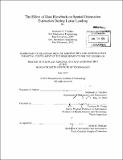The effect of dust blowback on spatial orientation estimation during lunar landing
Author(s)
Tritchler, Stephanie E. (Stephanie Elaine)
DownloadFull printable version (20.87Mb)
Other Contributors
Massachusetts Institute of Technology. Department of Aeronautics and Astronautics.
Advisor
Laurence R. Young.
Terms of use
Metadata
Show full item recordAbstract
Landing is a dangerous and complex phase of any flight. Landing on an airless, dusty world presents unique challenges to perception, including dust blowback. During crewed lunar landings, astronauts will either be directly piloting the lander or supervising the automation in the event they need to take over piloting duties. An accurate perception of vehicle attitude is critical if the astronaut is to bring the craft down safely. We aim to study human perception of orientation under different visual cues using a helicopter simulator. We conducted a simulator-only lunar landing experiment with seventeen helicopter pilot subjects at USAARL utilizing the 6 degree-of-freedom moving-base UH-60 helicopter simulator. The subjects did not fly the simulator but continuously indicated his/her perceived pitch and roll angles throughout each trial by keeping a modified joystick aligned with Earth vertical, and the accuracy of the responses has been analyzed to determine the effect of visual cue on attitude perception. The subjects experienced recorded trajectories under five different visual conditions: no visual cues, out-the-window cues with no, medium, and high dust, and instrument cues. Regression models were fit to the correlations between the Subjects' indicated perceived pitch and roll angles and the simulator model pitch and roll angles. It was found that the no vision cue severely hindered the subjects' ability to accurately perceive craft attitude, while the instrument cue enhanced it. The effect of the different levels of dust, as compared to out-the-window no dust condition and the instrument conditions were not statistically significant, though they were better than no vision.
Description
Thesis (S.M.)--Massachusetts Institute of Technology, Dept. of Aeronautics and Astronautics, 2013. This thesis was scanned as part of an electronic thesis pilot project. Cataloged from PDF version of thesis. Includes bibliographical references (p. 97-98).
Date issued
2013Department
Massachusetts Institute of Technology. Department of Aeronautics and AstronauticsPublisher
Massachusetts Institute of Technology
Keywords
Aeronautics and Astronautics.